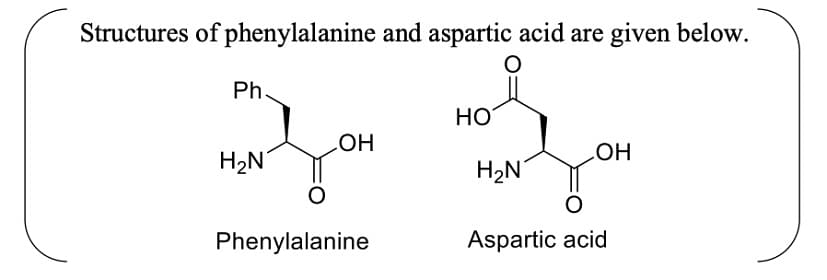Aspartame, an artificial sweetener, is a dipeptide aspartyl phenylalanine methyl ester. The structure of aspartame is


The Correct Option is B
Approach Solution - 1
Step 1: Understanding Aspartame
Aspartame is a dipeptide formed by the condensation of aspartic acid and phenylalanine. The methyl ester group is added to the carboxyl group of the phenylalanine residue.
Step 2: Structural Features of Aspartame
- Peptide bond: Formed between the carboxyl group of aspartic acid and the amino group of phenylalanine.
- Methyl ester group: Attached to the terminal carboxyl group of phenylalanine.
Step 3: Verifying the Structure
Structure (B) correctly shows the peptide bond between aspartic acid and phenylalanine, with the methyl ester group on phenylalanine.
Conclusion
The correct structure of aspartame is represented by option (B).
Approach Solution -2
To solve the problem, we need to determine the correct structure of aspartame, which is a dipeptide consisting of aspartyl phenylalanine methyl ester.
1. Understanding the Components:
Aspartame is made from aspartic acid and phenylalanine, with the phenylalanine part esterified as a methyl ester.
- Aspartic acid has two carboxyl groups, one of which forms a peptide bond.
- Phenylalanine contains a phenyl (Ph) group attached to the alpha carbon.
2. Structure of Aspartame:
- The amino group of phenylalanine bonds with the carboxyl group of aspartic acid.
- The free carboxyl group of phenylalanine is converted to methyl ester (–COOCH₃).
- The resulting structure is a dipeptide: aspartyl-phenylalanine methyl ester.
3. Identifying the Correct Option:
Among the given options, option (B) correctly shows:
- Aspartic acid with free amino and carboxyl groups.
- Phenylalanine linked via peptide bond.
- Methyl ester group at the carboxyl terminal of phenylalanine.
Thus, option (B) is the correct structure of aspartame.
Final Answer:
Option (B)
Top Questions on Biomolecules
- Scurvy is caused due to deficiency of
- CBSE CLASS XII - 2025
- Chemistry
- Biomolecules
- Assertion (A): Vitamin D cannot be stored in our body. Reason (R): Vitamin D is fat-soluble vitamin and is not excreted from the body in urine.
- CBSE CLASS XII - 2025
- Chemistry
- Biomolecules
- The carbohydrates are stored in animal body as
- KEAM - 2025
- Chemistry
- Biomolecules
- Identify the correct statements regarding the enzymes
I) Almost all enzymes are proteins
II) Enzymes are not specific in nature
III) Enzymes work effectively in the pH range of 5–7
IV) Enzymes work effectively between 310 K and 330 K temperature- AP EAPCET - 2025
- Chemistry
- Biomolecules
- Identify the sets in which enzyme, its source and enzyme reaction are correctly matched:
I) maltase, yeast; proteins $\rightarrow$ peptides
II) diastase, malt; starch $\rightarrow$ maltose
III) zymase, yeast; glucose $\rightarrow$ C$_2$H$_5$OH + CO$_2$- AP EAPCET - 2025
- Chemistry
- Biomolecules
Questions Asked in JEE Advanced exam
- The correct order of the wavelength maxima of the absorption band in the ultraviolet-visible region for the given complexes is:
- JEE Advanced - 2025
- coordination compounds
- Calculate the sum of magnetic moments (in Bohr Magnetons, B.M.) of the complexes: \[ [\mathrm{MnCl}_6]^{3-} \quad \text{and} \quad [\mathrm{Mn(CN)}_6]^{3-} \]
- JEE Advanced - 2025
- coordination compounds
- Consider the depicted hydrogen (H) in the hydrocarbons given below. The most acidic hydrogen (H) is:
- JEE Advanced - 2025
- Acids and Bases
- Consider a star of mass $ m_2 $ kg revolving in a circular orbit around another star of mass $ m_1 $ kg with $ m_1 \gg m_2 $. The heavier star slowly acquires mass from the lighter star at a constant rate of $ \gamma $ kg/s. In this transfer process, there is no other loss of mass. If the separation between the centers of the stars is $ r $, then its relative rate of change $ \frac{1}{r} \frac{dr}{dt} $ (in s$^{-1}$) is given by:
- JEE Advanced - 2025
- Gravitation
- A projectile is thrown at an angle of \(60^\circ\) with the horizontal. Initial speed is \(270\, \text{m/s}\). A linear drag force \(F = -CV\) acts on the body. Find the horizontal displacement till \(t = 2\) seconds. Given \(C = 0.1\, \text{s}^{-1}\).
- JEE Advanced - 2025
- Projectile motion




